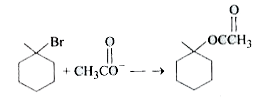In which of the following does the reaction go almost to completion ?
A⇔B(K=103)
P⇔Q(K=10−2)
A+B⇔C+D(K=10)
X+Y⇔XY2(K=10−1)
The correct Answer is:A
To determine in which of the following reactions the reaction goes almost to completion, we need to analyze the equilibrium constant (Kc) for each reaction. The higher the value of Kc, the more the reaction favors the formation of products, indicating that the reaction goes almost to completion.
1. Understand the Concept of Equilibrium Constant (Kc):
- The equilibrium constant (Kc) is defined for a general reaction:
aA+bB⇌cC+dD
as:
Kc=(C)c(D)d(A)a(B)b
- Here, (C) and (D) are the concentrations of the products, and (A) and (B) are the concentrations of the reactants.
2. Analyze the Relationship Between Kc and Reaction Completion:
- A higher value of Kc indicates a greater concentration of products at equilibrium. Therefore, if Kc is significantly greater than 1, it suggests that the reaction favors products, meaning it goes almost to completion.
3. Evaluate the Given Options:
- Suppose the options provided are:
- Option 1: Kc = 103
- Option 2: Kc = 101
- Option 3: Kc = 10−1
- Option 4: Kc = 10−3
4. Compare the Values of Kc:
- Among the given options, Kc=103 (Option 1) is the highest value.
- The other values 101, 10−1, and 10−3 are significantly lower than 103.
5. Conclusion:
- Since Option 1 has the highest Kc value, it indicates that the concentration of products is the highest in this reaction compared to the others.
- Therefore, the reaction corresponding to Option 1 goes almost to completion.
Final Answer:
- The reaction that goes almost to completion is Option 1: Kc = 103.
- The equilibrium constant (Kc) is defined for a general reaction:
aA+bB⇌cC+dD
as:
Kc=(C)c(D)d(A)a(B)b
- Here, (C) and (D) are the concentrations of the products, and (A) and (B) are the concentrations of the reactants.
- A higher value of Kc indicates a greater concentration of products at equilibrium. Therefore, if Kc is significantly greater than 1, it suggests that the reaction favors products, meaning it goes almost to completion.
- Suppose the options provided are:
- Option 1: Kc = 103
- Option 2: Kc = 101
- Option 3: Kc = 10−1
- Option 4: Kc = 10−3
- Among the given options, Kc=103 (Option 1) is the highest value.
- The other values 101, 10−1, and 10−3 are significantly lower than 103.
- Since Option 1 has the highest Kc value, it indicates that the concentration of products is the highest in this reaction compared to the others.
- Therefore, the reaction corresponding to Option 1 goes almost to completion.
- The reaction that goes almost to completion is Option 1: Kc = 103.
Topper's Solved these Questions
- EQUILIBRIUMBook:AAKASH INSTITUTE ENGLISHChapter:EQUILIBRIUMExercise:ASSIGNMENT (SECTION -A)
Explore 50 Videos
- EQUILIBRIUMBook:AAKASH INSTITUTE ENGLISHChapter:EQUILIBRIUMExercise:ASSIGNMENT (SECTION -B)
Explore 35 Videos
- EQUILIBRIUMBook:AAKASH INSTITUTE ENGLISHChapter:EQUILIBRIUMExercise:TRY YOURSELF
Explore 52 Videos
- ENVIRONMENTAL CHEMISTRYBook:AAKASH INSTITUTE ENGLISHChapter:ENVIRONMENTAL CHEMISTRYExercise:ASSIGNMENT (SECTION-D) (Assertion - Reason Type Questions)
Explore 4 Videos
- GENERAL PRINCIPLES AND PROCESSES OF ISOLATION OF ELEMENTSBook:AAKASH INSTITUTE ENGLISHChapter:GENERAL PRINCIPLES AND PROCESSES OF ISOLATION OF ELEMENTSExercise:Assignment (Section-D) Assertion-Reason Type Question
Explore 15 Videos
Similar Questions
Knowledge Check
In which of the following case, does the reaction go farthest to completion ?
AK=102BK=10−2CK=10DK=1Which of the following reactions will go faster if the concentration of the nucleophile is increased ?
A B
B C
C DNo comparison between these reactions
DNo comparison between these reactions
Complete the following reaction

View SolutionComplete the following reaction

View SolutionComplete the following reaction
_S01_428_Q01.png)
View SolutionWhich of the following substances is reabsorbed almost completely in PCT of nephron by active process?
View SolutionWhich of the following reaction does not occur?
View SolutionWhich of the following reactions does not take place?
View Solution
